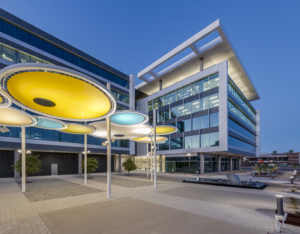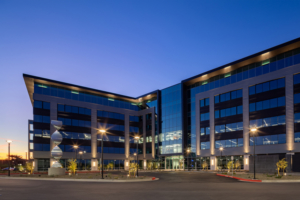Figuring out the bottom line return on investment figures for installing solar panels on commercial buildings is a bit like hitting a moving target. Incentives from utilities are apt to change and sow uncertainty in the market, thus access to capital can be iffy in these challenging economic times.
But some business owners who have installed systems in the past year agree: The right incentive package from Arizona Public Service or Salt River Project, combined with federal and state tax incentives, makes solar a good financial — as well as environmental — bet.
Here is a snapshot of two businesses that managed to put the right ingredients together.
Cowley Companies and APS
Cowley Companies, a Phoenix real estate investment firm, placed one of the largest commercial rooftop solar arrays in the country on one of its warehouses near 25th Avenue and Buckeye Road.
The project cost $11.5M and includes 7,872 panels, which generate about 2.4 megawatts of power. According to CEO Mike Cowley, the solar array is producing half of the electricity needed in the 850,000 SF building, which includes tenants with industrial refrigeration requirements. His annual bill had been running about $1M.
Cowley says he had to sign a non-disclosure agreement with APS and cannot reveal what the utility company is paying him per kilowatt hour, but the agreement obligates APS to pay incentives until 60% of the project costs — the amount he borrowed to finance the project — is paid off. The incentive payments cover the loan payments. Cowley estimates that will take about 12 years.
He’ll recoup 30% of the cost through a federal tax credit. Additionally, tenants now reimburse him for power used. With that mix of incentives and payments, he calculated his self-financed portion of the project, about 10%, will be paid off in about six years.
With a 25-year warranty on the panels, the decision to erect the array made good financial sense, Cowley says.
In 2009, APS established a reverse-auction system that requires commercial entities to bid for an incentive package. Spokesman Steven Gotfried says APS scores each application and awards the bid to those who produce the most electricity for the lowest incentives.
APS’ calculator takes into account the system size, the amount of energy it is expected to produce, the incentive requested and years of payment. The lower the score, the smaller the incentive per kilowatt hour requested. Incentives are then awarded starting with the lowest score. This continues until all the funds are allotted. It’s a competitive, market-driven process designed to lower incentives.
Lower incentives, Cowley says, would have made his deal less feasible.
“People are not going to get excited about a 20-year payback,” he says. Businesses may even “be waiting for SRP and APS to bring the rate back up to where solar makes sense again.”
Gotfried says APS is trying to find the right balance between offering too few and too many incentives, with a finite pool or resources.
“The goal at the end of the day is to drive down the cost of solar,” he says. “The incentives weren’t meant to go on forever, they were meant to get things started.”
The price of solar panels has dropped 50% in the past three years, says Lee Feliciano, president of the Arizona Solar Energy Industries Association and a solar developer with CarbonFree Technology.
There may come a time, he says, when the industry no longer offers incentives for the panels, but that day is not yet on the horizon.
“The incentives are there to position the industry,” Feliciano says. “A lot of the biggest industries in the country would not be here without incentives.”
Even with incentive amounts dropping, installing solar panels on a commercial building can still be a good deal, says Gary Held, sales and marketing manager with Harmon Solar, which worked on the Av-Air project.
With incentive rates running around 10 cents to 12 cents per kilowatt hour, someone with access to capital can have a system paid off in about eight years. With a 20-year production-based incentive, that still makes financial sense, he says.
An owner who leases a system can see the end of lease payments in about 12 years and have eight years of incentives.
“We shout from the rooftops: If you are a commercial business owner with cash or access to capital with good credit, putting solar on your rooftop is a sound investment,” Held says.
Av-Air and SRP
“I am extremely satisfied with the way it is turning out for us,” says Bob Ellis, president of Reason’s Aviation, the parent company of Av-Air, a Chandler-based company that offers aftermarket parts and services to the airline industry.
Harmon Solar of Phoenix installed a 151,800-watt photovoltaic system made up of 550 solar panels on Av-Air’s rooftop, which is equivalent to about 20 residential-sized systems.
Ellis says the total cost of the project was $808,000. About 30% of the cost was covered by a federal grant and $25,000 will come back to him as a state tax credit, which is available to companies whose solar systems are operational this year.
The solar array covers 100% of his energy needs and SRP, he says, is paying him an incentive of 21.4 cents per kilowatt hour for 10 years, which comes out to $6,000 a month. Add that to the approximate $4,000 a month his tenants pay him for solar generated electricity and the fact that he’s no longer paying an electric bill, and the decision to go solar was “a no-brainer.” Ellis says it will take him about four years to pay back his $560,000 in up-front, out-of-pocket expenses.
The only downside to the process occurred when none of the four or five banks he does business with would lend him money for the out-of-pocket expenses, saying they were too unfamiliar with the incentive process.
Ellis also concedes it may be difficult for companies today to replicate Av-Air’s circumstances because SRP’s incentives are much less generous than they were in 2009.
“It was a really good deal and I got in on it just at the right time,” he says.
Both SRP and APS have production based incentive (PBI) programs for medium- and large-sized commercial customers. PBIs pay a customer over time based on the amount of energy produced, as opposed to the up-front incentives given to homeowners or small-business owners.
SRP now offers a PBI of 12 cents per kilowatt hour for 20 years for the first two megawatts of power applied for, but lowers the funding to 11 cents and then 10 cents respectively for each successive two megawatts. Its annual pool is for six megawatts.
Lori Singleton, SRP manager for sustainable initiatives and technology, says the utility simply has a finite set of resources and is trying not to over-subsidize an emerging industry.
“As the cost of solar decreases and demand increases, we have restructured our solar incentives to reflect that,” Singleton says. “It has been our intent from the beginning to reduce the rates as prices come down, so one day the industry can stand on its own without incentives.”
Reducing incentives also allows SRP to provide them to more customers, she says.



